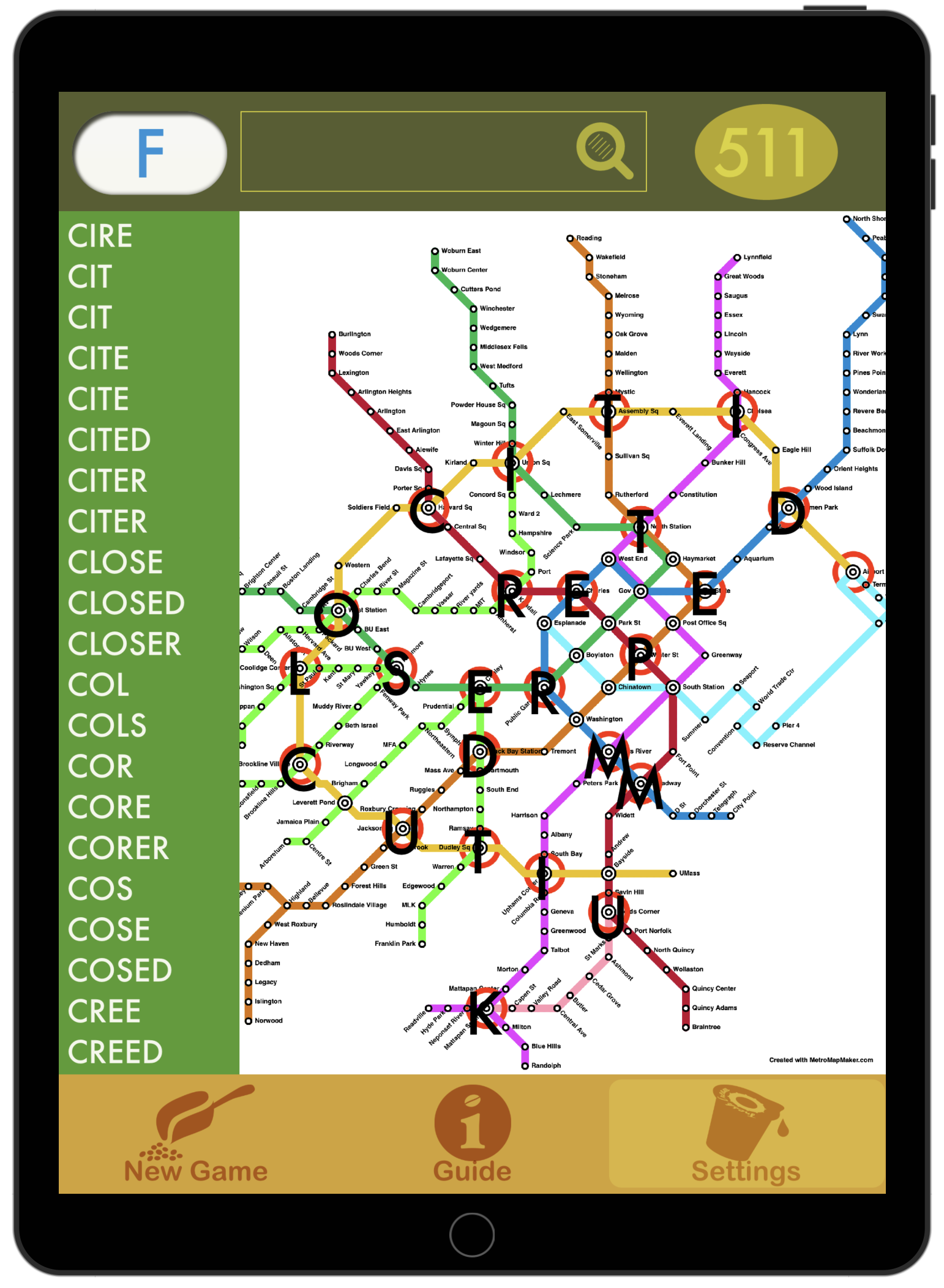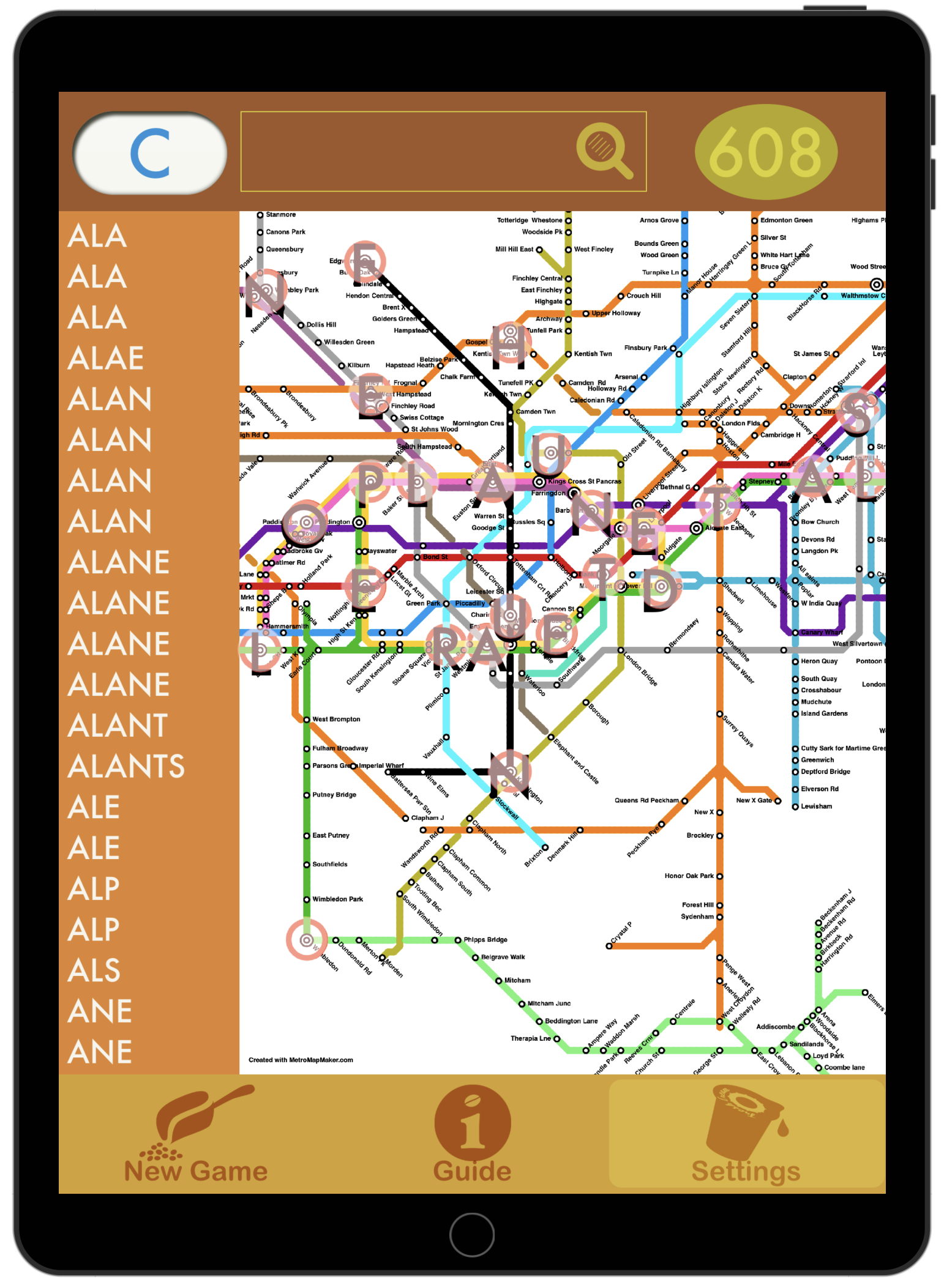In our search for mockup ideas, some themes suggest themselves more readily than others. One that occured to us pretty early on was maps of subway lines and stations. Today we take the concept for a spin, finding some gameplay guardrails it’d be good to stay within. The only trolley car problem will be where to tie which letters to which lines. To supplement the normal words that scored in test play, as is our custom we’ll list a selection of faux-cabulary. These creations sound like the real thing, but have never made it to any dictionary except ours.
Lay your own track
Transit maps have to be diagrams for relationships and balanced use of space, so geographic accuracy is the first casualty. Also, though we’d love to use the iconic published versions of maps, they’re understandably trademarked. So we made use of a handy website called metromapmaker.com. It lets you draw out your own versions, real or imagined, and maps published on the site become public domain.
Check out their gallery of speculative metros, or map your own path to deep-diving, diversion or destiny. Or your dog’s favorite digs. Like those sarcastic flowcharts you’ve seen, but with straps, swaying, wafting scents and tinny undiscernable announcements. Both diagrams here were made by users there, so we appreciate their handiwork. Non-transfer stations (single circle) are shown here for decoration.
Sticky wickets
The first choice had to be Boston’s T system. Beantown’s layout has a good level of complexity and size, and you know we can’t resist a good bean connection. For the second run, we chose the London Tube for its legendary stature and international appeal. Ranking second in design only to the Concorde SST, London’s underground map is still an object lesson to designers today. We apologize for the letters in the first game being hard to read. We intended to have it appear like the London test, which itself was a fail, but left out a step.
And the London letters look like they’re squished under so much bubble gum. Certainly not what we had in mind. The three thin Boston I’s are especially hard to see, running parallel to the Green Line and purple Fairmount Line. The resolution of the mockup itself was okay, but was lost in these screenshots, so local stations’ mileage may vary. As usual, these are just first drafts of potential variations. Unfortunately, repeated computer troubles prevented redos in time for the blog. Just a mini comedy of errors this time to keep us petticose (see below).
All about connections
It quickly became clear the connections between letters would be too complex without some limits. So one constraint is, there can only be direct connections between any two stations on the same line. A word can include stations on different lines as long as the lines share a (transfer) station in the word. For example, a 3-letter word from Assembly (Orange Line, top center) to Public Garden (Green Line, center), is okay. That’s because the middle letter, North Station, is on both lines. In this case, TTR isn’t a word, but that route is eligible.
Changing places
On the other hand, Assembly to Charles (Blue Line, center) via North Station is not okay. That’s because there’s no single line connecting Charles and North Station. In real life you could transfer at West End (Fairmount Line), but that station isn’t in any word here. Letter placing possibilites, randomly chosen every game from among double-black-circle junction stations, are circled in red. A word can transfer from one line to another as long as the transfer point has a red circle.

Make up your mind
Determitude: Perseverence; persistence; fortitude; commitment.
Percol: The state or sense of being ready: His percol was never in question.
Ditter: To dally, linger or lollygag; to allow a pointless conversation to drone on.
Petticose: Festeringly annoyed by a minor mishap, as when stepping on bubble gum in a public place.
Crittered: Populated with animals.
Ummitude: Indecisiveness or hesitancy; lack of committment; apathy; wishy-washiness.

How you know what you know
Operal: Describes learned (by observation or experience) knowledge that is still intuitive and can’t be easily explained, as that of people whose job is to distinguish between male and female chicks.
Unula: A small bone near the nose.
Shelp: To shuffle or scuff one’s feet in a slow-moving crowd, as in and underground walkway at rush hour: Don’t shelp in the subway, sugar. (song lyric)
Ponetal: Plausible but totally made up technobabble, as in B sci-fi movie dialogue or this farsighted short; Faux-munication.
Senople: Pleasure felt simply by seeing someone else treat themselves, as an older man buying an ice cream cone on a sunny day.
Heluf: Large, noticeable or formidable: There’s a heluf asymmetry in some subway maps.
No Comments